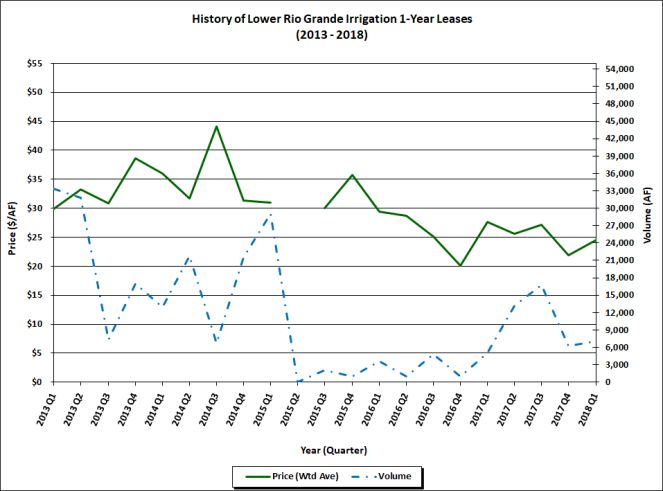Demand for Lower Rio Grande water created a lease market in south Texas. Lease prices vary by use, with agricultural water users typically paying lower rates per acre-foot because they have lower consumptive use of water.
Municipal users have priority in the system, with a municipal reserve of 225,000 AF reestablished each month. Excess water is allocated to irrigators, who must have a balance available in a revolving account to take delivery of water. The long-term average allocation for Lower Rio Grande contracts is 2.5 AF/acre.
Between 2009 and early 2011, water supplies were abundant, and the watermaster could provide full allocations (4 AF/acre), and during flood operations at the Falcon and Amistad Dams, the Rio Grande Watermaster provided “free water” that does not count against contractors’ accounts. As a result, leasing activity for irrigation water was sparse during that time.
Record-breaking rainfall and flooding in the spring of 2015 led to a similar situation depressing leasing activity for 2015. The low level of activity continued in 2016, when the March-to-May rainfall totaled 200% to 300% of average for much of the valley. Only 10,359.84 AF of irrigation water changed hands over the year—less than 10% of the annual volume for 2012, the highest year on record. Autumn and earlier winter 2017 was hot in the Rio Grande Valley, with record or near-record temperatures throughout the season. A major storm in early October brought temporary relief from the moderate to severe drought conditions in the region, and another storm in mid-November brought a deluge—with some areas seeing as much as three times the monthly average rainfall in just a few hours. While there was little meaningful precipitation otherwise, these two storms brought enough precipitation to break the trend of a continuing pick-up in trading.

Activity increased in the first quarter of 2018, compared to the previous quarter and the first quarter of last two years, but is below the historic average. The first quarter of 2018 saw 26 transfers of irrigation water totaling 7,126 AF—compared to 6,202.24 AF in the fourth quarter of 2017, 5,036.11 AF in the first quarter of 2017, and 3,665 AF in the first quarter of 2016. Over the last 10 years, first quarter volumes ranged from 0 AF (no trades) to 33,377.48 AF, with an average of 8,808 AF.

Prices for the first quarter of 2018 averaged $24.56/AF—which is higher than the fourth quarter of 2017 but lower than the rest of 2017. Average prices were at $21.87 in the fourth quarter, $27.18/AF in the third quarter, $25.58/AF in the second quarter, and $27.61/AF in the first quarter of 2017.
Current prices are low for first quarter prices. Over the last 10 years, first quarter prices have ranged from $27.61/AF to $35.94/AF, with average of $29.67/AF (excluding any quarters in which no trades occurred).
Because municipal users have priority in the system, the market for leases of municipal water typically is thin. In the first quarter, activity involving municipal water was limited to a single administrative transfer of 100 AF from Harlingen Waterworks to the City of Primera. Because it was an administrative transfer, there was no price associated with that water.
Activity for industrial use and mining is also limited. The first quarter saw three transactions for mining use. In one transaction a civil construction company specializing in underground utility construction and roadwork, leased 2,000 AF for two years at price $150/AF. The remaining two transactions were one-year leases of 133 AF each to an oil and gas company at a price of $1,000/AF.
With the exception of a few isolated areas, the Lower Rio Grande Valley saw below normal precipitation levels in the first quarter and many parts of the region are facing moderate to severe drought conditions. The U.S. Department of Agriculture and the Texas Agrilife Extension Service expect short to very short soil moisture levels. Expect trading to pick up.
Written by Marta L. Weismann
You must be logged in to post a comment.